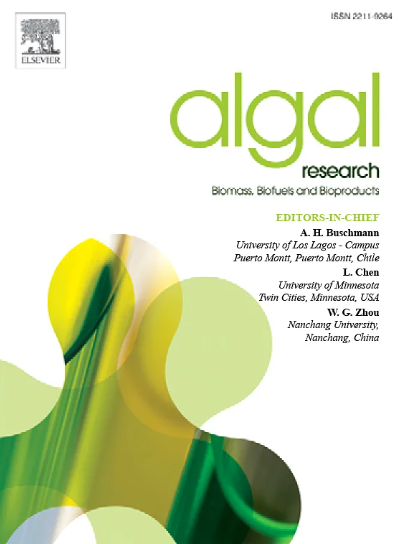Global phylogeny, biogeography, and evolution of the agarophyte family Gracilariaceae with key insights into broadly distributed and cultivated species
IF 4.6
2区 生物学
Q1 BIOTECHNOLOGY & APPLIED MICROBIOLOGY
Algal Research-Biomass Biofuels and Bioproducts
Pub Date : 2025-03-09
DOI:10.1016/j.algal.2025.103994
引用次数: 0
Abstract
This study investigates the global phylogeny, biogeography, and evolutionary history of Gracilariaceae, an ecologically and economically significant red algal family, with insights into cultivated and broadly distributed species. Using all available cox1 and rbcL DNA sequences and associated biogeographic data, we constructed the most comprehensive Gracilariaceae phylogeny and time-tree to date, mapping DNA-supported species distributions. Our dataset includes 161 Gracilariaceae lineages, of which 121 correspond to currently accepted species names. This dataset represents approximately 50 % of the currently described diversity within the family. However, considering all 161 lineages, our sampling covers approximately 66 % of the potential diversity represented by currently described species. Phylogenetic analyses resolved eight distinct clades, confirming the monophyly of Gracilaria, Gracilariopsis, and Melanthalia, but not Curdiea. Divergence time estimates place the Gracilariaceae crown group origin in the Jurassic (~170 Mya), with a Paleogene diversification burst. Global diversity hotspots occur in the tropical Central Indo-Pacific and Atlantic, followed by Northern Temperate regions. Approximately 73 % of species diversity is tropical, with 85 % concentrated in the Central Indo-Pacific and Atlantic. Biogeographic reconstructions suggest a Central Indo-Pacific origin for the order, followed by global dispersal and diversification hotspots in the same tropical regions. Macroevolutionary analyses reveal varying speciation patterns across clades, with the youngest, originating in the tropical Atlantic, exhibiting a notable speciation burst associated with flattened thallus morphology, suggesting a link between morphology and diversification. Geographic range restriction is typical in Gracilariaceae, with 84 % of species limited to a single longitudinal and 80 % to a single latitudinal region. Widely distributed species are exceptional and include previously documented introduced species. We identified 15 species with wide or disjunct distributions, detailing their geographic distribution and potential origins. Aquaculture poses invasion risks, as 10 of the 38 cultivated species exhibit broad or disjunct distributions, including previously documented cases of introduced species.

本研究调查了红藻科(Gracilariaceae)的全球系统发育、生物地理学和进化史,红藻科是一个具有重要生态和经济意义的红藻科,研究深入到栽培和广泛分布的物种。利用所有可用的 cox1 和 rbcL DNA 序列以及相关的生物地理学数据,我们构建了迄今为止最全面的蓠科植物系统发育和时间树,绘制了 DNA 支持的物种分布图。我们的数据集包括 161 个蓠科植物世系,其中 121 个世系与目前公认的物种名称相对应。该数据集约占目前该科描述多样性的 50%。然而,考虑到所有 161 个品系,我们的取样涵盖了目前描述物种所代表的潜在多样性的约 66%。系统发育分析确定了 8 个不同的支系,证实了 Gracilaria、Gracilariopsis 和 Melanthalia 的单系性,但不包括 Curdiea。根据分化时间的估计,栅栏草科冠群起源于侏罗纪(约 170 Mya),古近纪的分化爆发。全球多样性热点地区位于热带中印度洋-太平洋和大西洋,其次是北温带地区。大约 73% 的物种多样性属于热带,其中 85% 集中在印度洋-太平洋中部和大西洋。生物地理重建表明,该目起源于中印度洋-太平洋地区,随后在相同的热带地区出现了全球扩散和多样化热点。宏观进化分析表明,各支系的物种分化模式各不相同,最年轻的支系起源于热带大西洋,表现出明显的物种分化爆发,与扁平的菌柄形态有关,这表明形态与物种分化之间存在联系。地理分布范围的限制是蓠芭科的典型特征,84%的物种局限于单一的经度地区,80%的物种局限于单一的纬度地区。分布广泛的物种是例外情况,其中包括以前记录的引入物种。我们确定了 15 个分布广泛或不相连的物种,详细说明了它们的地理分布和潜在起源。水产养殖具有入侵风险,因为在 38 个养殖物种中,有 10 个物种的分布范围很广或不相连,其中包括以前记录的引入物种。
本文章由计算机程序翻译,如有差异,请以英文原文为准。
求助全文
约1分钟内获得全文
求助全文
来源期刊

Algal Research-Biomass Biofuels and Bioproducts
BIOTECHNOLOGY & APPLIED MICROBIOLOGY-
CiteScore
9.40
自引率
7.80%
发文量
332
期刊介绍:
Algal Research is an international phycology journal covering all areas of emerging technologies in algae biology, biomass production, cultivation, harvesting, extraction, bioproducts, biorefinery, engineering, and econometrics. Algae is defined to include cyanobacteria, microalgae, and protists and symbionts of interest in biotechnology. The journal publishes original research and reviews for the following scope: algal biology, including but not exclusive to: phylogeny, biodiversity, molecular traits, metabolic regulation, and genetic engineering, algal cultivation, e.g. phototrophic systems, heterotrophic systems, and mixotrophic systems, algal harvesting and extraction systems, biotechnology to convert algal biomass and components into biofuels and bioproducts, e.g., nutraceuticals, pharmaceuticals, animal feed, plastics, etc. algal products and their economic assessment
 求助内容:
求助内容: 应助结果提醒方式:
应助结果提醒方式:


